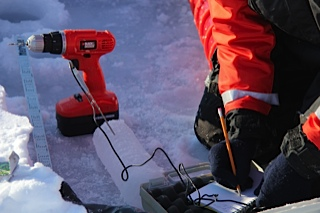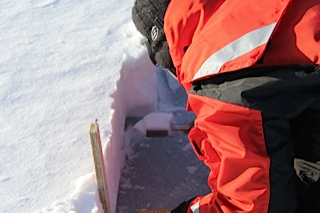
Field research in Greenland: A student’s perspective
David Babb is a M.SC student in physical geography who just returned from the Zackenberg Research Station in Daneborg, NE Greenland (74N). There, he participated in the 2014 Young Sound field campaign, a research initiative of the Arctic Science Partnership that involves researchers and graduate students from U of M, Denmark (Aarhus University), Greenland (Greenland Institute of Natural Resources).
His project is a case study on the seasonal transition of geophysical parameters of different ice types in Young Sound, on the northeast coast of Greenland.
Because the effects of climate change are having impacts locally and hemispherically and as a result are altering sea ice processes, this research will lead to a better understanding of the geophysical and thermodynamic processes occurring at the ocean-sea ice-atmosphere (OSA) interface as the snow melt, melt pond evolution and sea ice breakup periods occur. The Daneborg Research Station is ideally situated to compare two different ice types, thick first year ice (inner-fiord) and young ice (polynya region), and monitor their thermodynamic and geophysical responses throughout the transition from cold winter ice to breakup.
The project focuses on analyzing the geophysical properties of snow and sea ice, coincident meteorological and remote sensing data; ultimately leading to increased knowledge of how remote sensing signatures respond to various features in young ice types during the seasonal transition from winter into summer.
UM Today caught up with the MSc. student right after he defended his thesis to ask him about his recently completed field work.
What were you working on in Greenland?
I was working on the sea ice component of a multidisciplinary project as part of the Arctic Science Partnership studying the ocean-sea ice- atmosphere system of Young Sound, Greenland. Specifically I deployed several automatic systems in October that recorded air, ice and water temperatures, ice growth, snow depth and surface winds throughout the entire Greenlandic winter. Upon returning in May we collected the data and recovered the equipment. I also surveyed the fjord for ice thickness and snow depth so that we have an idea of the spatial variability of these properties and can relate them back to processes studied by the other scientists. I was at the Daneborg research station for 4 weeks this time, but I had also been there for two weeks in October. I will be going on the Amundsen for 6 weeks this fall in the Canadian Arctic.
What are the benefits of being able to go out into the field to do research?
While we use a lot of satellite data for our work, we rely heavily on data collected in the field out on the ice. Going into the field allows you to collect a more holistic view of the system which helps to better answer our research questions, though it usually leads to more questions.
What do you like about field research?
There are many things that I enjoy about field work. I enjoy the adventure of working in remote places in sometimes harsh conditions and studying something that perhaps nobody has studied before. I enjoy that it heavily relies upon team work, whether its helping someone with their work or cooking dinner/reheating dinner for people who have been out on the ice all day, its important that everyone pitches in. I also believe that scientifically its important to go to the field and get your hands wet/cold as you try and take notes or collect samples. I guess you could say it makes you appreciate the data more and provides more context than just looking at a dataset on your computer.
Read more about the 2014 Young Sound Campaign.
>> Scroll down for a report from Dave Babb on the progress of the first leg of the study — some gorgeous photos from the land of ice, in the face of the sobering reality of glacial melt.
May 30, 2014
Leg 1 of the Young Sound research project in Northeast Greenland has come to a close after a great four weeks at the Daneborg research station. We have returned south where green grass is a welcome change from the snow drifts that we have been shovelling through and travelling across for the past month.
On April 29 we took off from Akureyri Iceland and headed north, first to Constable Point to refuel and then onwards to Young Sound and the Daneborg research station. The flight up the northeast side of Greenland offers some tremendous views and is made all the more enjoyable by the hum of a twin otter, which is the best and in most cases only way to get around in the north. Out the right side we get a great view of the icepack in the Greenland Sea that has just been exported from the Arctic Ocean through Fram Strait. Interspersed within the pack ice are icebergs, given that they are visible from several thousand feet the bergs must be massive.
Out the left side we get a breathtaking view of the mountains, glaciers and fjords along the Greenlandic coast. This is my second time to Daneborg and this time I made sure to have a seat on the left side so I could fully take in the beauty of the Greenlandic coast. Soon we begin to descend over Clavering Island and make the approach to the gravel air strip, the fjord is completely covered with a perfectly undisturbed snow cover. After a quick touchdown we unload the plane and are met by members of the Sirius dog sledge patrol and some of their Greenlandic sledge dogs. The dogs are almost as excited as we are, as they jump and paw all over us. Soon we are off to the station to open it up for the first time since a small group of us left on November 1. First the heat gets turned on and then we begin the endless chore of melting snow that we use for drinking and cooking. The key to shoveling snow into the water tanks is to avoid areas of yellow snow from the wildlife and muskox turds that seem to be everywhere.
We quickly settled in, unpacked and began the research. Within the first few days several of us were off to check on the automated equipment we deployed last October. We unfortunately had a few systems fail but are ecstatic to shovel out several systems that have operated all winter. I had deployed two ice mass balance buoys in October that measure ice thickness, snow depth, ice temperatures, air temperature, water temperature, air pressure and wind speed. One was unfortunately flooded out when the surface of the ice was depressed during a large snowfall. But the second one has worked perfectly. We uncover the logger case that is under 40cm of snow, connect our laptop and immediately download over 8 months of data collected at 30 minute intervals which is greater than 2 million values! After a round of high fives and an almost giddy look on my face we check the instruments and close everything back up, leaving the instrument to collect data for another few weeks before it is recovered during leg 2. Upon returning to the station we are able to plot up the data and see how the ice grew through winter and how that is related to air temperatures and water temperatures, while also looking at the impact of snow on ice growth. The data looks great and we’re stoked to dive into it further once we have returned back south.
With 24 hours of daylight it is very easy to lose track of time and work long days. Temperatures ranged between -15C and +5C, with the latter coming around mid-day when the intense arctic sun was beating down on us. Given the highly reflective surface of the snow, sunburn was probably our biggest adversary. By the end we all had ‘Greenlandic tans’, sun tanned/burned hands and faces with some pretty well defined sunglass/ski goggle tan lines.
When we arrived at Daneborg on April 29 there was still a crispness of winter in the air, but that was quickly replaced by the feeling of spring. As a result we began to notice changes in the snow and subsequently in the ice with the onset of summer melt. Studying how the ocean, sea ice and atmosphere change during this transition is one of the goals of this project. Weekly CTD transects along the fjord and out of the fjord towards the Greenland Sea will reveal how the oceanography changes and how melt water from glacial runoff is dispersed within the fjord. Albedo measurements at two different sites aim to quantify how the changing snow/ice surface impacts the surface energy budget. Extensive physical sampling of ice cores and snow pits reveal how these two mediums change through the spring transition. In depth biogeochemical analysis of the sediment, water, ice and snow will reveal how specific chemicals and tracers move through the system. A fully outfitted meteorological tower provides high resolution data on atmospheric variables but also on gas and energy exchanges between the sea ice/snow and the atmosphere. Various other systems are suspended in the water column while cameras perched on the side of mountains will capture the evolution of melt ponds along the fjord. Leg 1 was busy with equipment setup, establishing study sites and collecting the first few weeks of data, now it is up to our colleagues on Leg 2 to continue the work through the spring transition.
It is nice to be back home now, watching hockey playoffs, rejoining my beer league slo-pitch team and enjoying spring, but there is a certain excitement of field work that I begin to miss. There is already talk of returning to Daneborg next year, and I can hardly wait.

CTD transect along Young Sound. L to R: Igor Dmitrenko, Soeren Rysgaard, Sergei Kirillov. // Photo Dave Babb

Wieter Boone and Odille Crabeck taking a break during physical sampling of the ice and snow. // Photo Dave Babb

Recovery of an Ice Tethered Profiler. L to R: Sergei Kirillov and Kunuk Lennert. // Photo Igor Dmitrenko

Leg 1 group shot. L to R: Satwant Kaur, Igor Dmitrenko, Sergei Kirillov, Soeren Rysgaard, Bjarne Jensen, Odille Crabeck, Ryan Galley, Dave Babb, Kunuk Lennert and Wieter Boone. Photo Wieter Boone
Research at the University of Manitoba is partially supported by funding from the Government of Canada Research Support Fund.













What an amazing experience to do field research like this! Congratulations on your thesis defense as well. I was curious, what was the composition of the research team? Mostly students/faculty? Was it mostly Canadian/Greenlandic involvement or were there participants from different Arctic countries? Finally, what sparked the opportunity for you?
Hi Lisa,
We were a group of 4 students (3 PhD’s, 1 MSc), 4 research associates, 1 Faculty member and 1 field technician. Of the 10 people, 7 were from the University of Manitoba, 2 from Greenland and 1 from Denmark, though team members hailed from Canada, Denmark, Greenland, Russia, India and Belgium.
This opportunity arose as part of my graduate work at the Center for Earth Observation Science at the University of Manitoba. The work was not directly related to my thesis, but I had deployed this equipment and carried out similar sampling in other areas of the arctic so I was offered the opportunity to join the project. When your advisor offers you an opportunity to work in Greenland, even though it may prolong your thesis, its really tough to say no.
Cheers,
-Dave